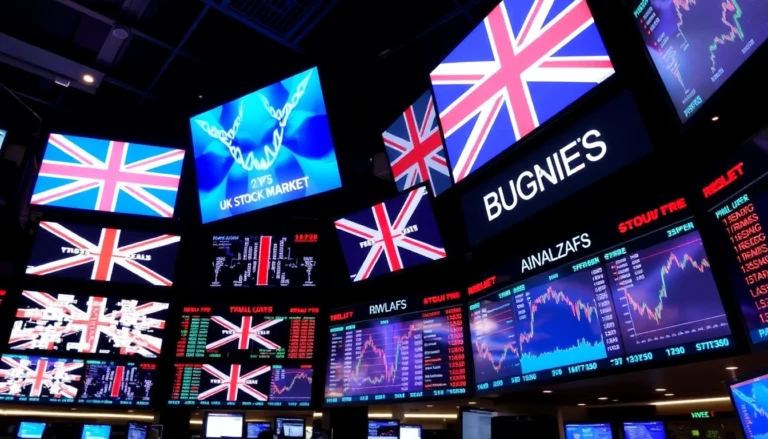The current landscape of Financial Markets News UK reflects a period of notable divergence and opportunity, driven by fluctuating equities, record-breaking commodities, and shifting currency dynamics. Understanding these trends is essential for investors aiming to navigate a complex environment marked by global economic uncertainties, technological innovations, and regulatory developments. This comprehensive analysis delves into recent market performances, currency movements, strategic investment approaches, regulatory outlooks, and technological advancements shaping the UK’s financial ecosystem.
Understanding Recent Trends in UK Financial Markets
Stock Market Performance and Key Indicators
Recent UK stock market performance has been characterized by marginal gains amidst heightened volatility. The FTSE 100 and broader European indices have shown resilience despite various headwinds, such as geopolitical tensions and economic data releases. For instance, the FTSE 100 experienced a modest rebound, led primarily by strong gains in banking and mining stocks, which benefited from rising commodity prices and easing global uncertainties. Moreover, the STOXX 600 closed up 0.17%, reflecting cautious optimism among investors. Key indicators such as the 200-week moving average continue to serve as critical trendlines, with many analysts emphasizing that a sustained stay above this level could signal a bullish phase, whereas a break below might trigger cautious recalibrations.
Market sentiment is also influenced by macroeconomic data releases, including inflation figures, employment reports, and GDP growth rates. The recent US labor data, indicating a resilient employment landscape, had a pronounced impact on currency and equity markets, often prompting a reassessment of monetary policy expectations. In addition, global events such as US-China trade tensions, European energy policies, and geopolitical conflicts remain pivotal factors influencing market volatility.
Gold Price Records and Investment Opportunities
The precious metal gold reached a historic high of $3,501.59 per ounce, surpassing previous records and signaling strong investor interest in safe-haven assets. This surge aligns with global economic uncertainties, inflation fears, and currency fluctuations, leading investors to seek refuge in tangible assets. Gold’s performance can be viewed as an indicator of broader market sentiment, with its rising price suggesting a cautious approach among investors amid geopolitical strains and inflationary pressures.
Investment opportunities in gold are further bolstered by strategic portfolio diversification. Investors should consider factors such as physical gold, ETFs, and mining stocks, each offering different risk-return profiles. For example, physical bullion provides direct exposure, while ETFs like GLD offer liquidity and ease of trading. Additionally, tracking gold’s correlation with other assets, including cryptocurrencies and equities, can help optimize portfolio resilience in uncertain times.
Impact of Global Events on UK Markets
UK markets are intricately linked to global events, including US monetary policy, Asian economic data, and international trade developments. Recent US rate cut hopes have bolstered equities and currencies, yet geopolitical tensions such as the Trump-Fed feud have introduced volatility. The political landscape, including Brexit-related uncertainties and US-China trade negotiations, continues to influence investor confidence. Notably, the extension of tariff delays between the US and China has provided short-term relief, yet underlying tensions persist, underscoring the importance of global risk assessment in UK investment strategies.
Similarly, China’s economic slowdown reflected in weak manufacturing and iron ore data could further impact commodity-linked sectors within the UK, such as mining and energy. Global supply chain disruptions and policy shifts necessitate vigilant market monitoring and adaptive investment positioning.
Analyzing Currency Movements and Forex Insights
Factors Driving the Pound and Dollar Fluctuations
The British Pound and US Dollar are experiencing fluctuating trajectories, driven by diverse macroeconomic factors. The Pound’s movement remains sensitive to Brexit negotiations, UK economic data, and Bank of England policies. Recent inflation figures and employment reports have influenced the Bank’s stance, with expectations of cautious interest rate adjustments. Meanwhile, the US Dollar has been impacted by Federal Reserve signals, inflation metrics, and geopolitical risk sentiments.
Currently, the dollar’s slight decline against major currencies mirrors market expectations of potential rate cuts or pauses. The dollar index, which measures the greenback against a basket of currencies, has shown vulnerability amid global growth concerns and dovish Fed rhetoric.
Effect of U.S. Labor Data on Currency Trends
U.S. labor data acts as a critical driver of forex movements. Recent reports indicating strong employment growth have supported the dollar, reinforcing expectations of a resilient economy that might delay rate cuts. Conversely, signs of wage stagnation or employment slowdown could weaken the dollar, prompting speculative shifts in forex markets. For UK investors, understanding these dynamics is vital for currency risk management, especially in cross-border trading and international investment portfolios.
Asian Currencies and International Trade Impact
Asian currencies, including the yen and yuan, have traded marginally higher on hopes of US rate cut expectations and Chinese economic stabilization measures. These currencies influence the UK through trade relations, with China remaining a significant trading partner. Weak economic data from China, such as subdued manufacturing output, can dampen commodity prices and impact sectors reliant on Asian supply chains. Conversely, policy interventions by Asian governments to support currency stability can mitigate broader market spillovers.
Investment Strategies in a Volatile Environment
Balancing Risk with Gold and Crypto Assets
Amid market volatility, diversification into gold and cryptocurrencies offers a strategic hedge. Gold, as historically proven, preserves value during inflationary and geopolitical crises, making it an essential component of a balanced portfolio. Cryptocurrencies, despite their high volatility, present opportunities for alpha generation and inflation hedging, especially when traditional markets face turbulence.
Experts recommend allocating a modest portion of portfolios to these assets—typically 5-10%—to enhance resilience. Careful selection of cryptocurrency holdings, focusing on liquidity and market cap, is essential, as the rapid pace of innovation and regulatory scrutiny can influence valuations.
Utilizing Stock and ETF Opportunities Amid Market Fluctuations
Stock and ETF selections should prioritize sectors showing resilience or growth potential amid market swings. Defensive stocks such as healthcare and consumer staples remain attractive, while ETFs targeting specific themes like green energy, technology, or commodities can provide diversification. Investors are also increasingly turning to thematic ETFs that exploit emergent trends, including AI, digital assets, and sustainable infrastructure.
Effective strategies include dollar-cost averaging, using technical analysis for entry and exit points, and leveraging stop-loss orders to mitigate downside risk. Keeping abreast of macroeconomic indicators and geopolitical developments further refines timing and sector focus.
Emerging Sectors and Alternative Investments
Emerging sectors such as artificial intelligence, blockchain, and renewable energy are gaining prominence. Companies integrating AI into financial services, like Meta’s recent app partnership explorations, exemplify innovation driving growth. Similarly, green energy companies benefit from policy shifts toward sustainability.
Alternative investments, including private equity, venture capital, and crowdfunding platforms, are attracting attention due to their potential for higher returns and diversification benefits. These require due diligence but can offer non-correlated assets to traditional markets, especially in a high-volatility environment.
Regulatory and Policy Outlook for UK Investors
Bank of England’s Cryptocurrency Stances and Limits
The Bank of England has issued cautious signals regarding cryptocurrencies, emphasizing the need for strict regulatory conditions before acceptance within mainstream finance. The upcoming Libra (now Diem) stablecoin project faces stringent approval criteria, including compliance with anti-money laundering and consumer protection standards. For UK investors, staying informed about evolving policies is vital to avoid regulatory pitfalls and capitalize on emerging digital currencies.
New Financial Legislation and Compliance Challenges
Recent legislative initiatives aim to tighten oversight of financial institutions and digital assets, including amendments to anti-money laundering laws and transparency requirements. Compliance complexities necessitate sophisticated risk management frameworks, especially for firms operating across borders. Investors must ensure adherence to reporting standards, such as FATF guidelines, to mitigate regulatory risks.
Influence of Political and Economic Policies on Markets
Political stability and policy clarity significantly influence market confidence. The UK government’s stance on fiscal stimulus, infrastructure investment, and trade agreements can create ripple effects across sectors. Monitoring parliamentary debates, policy announcements, and international relations helps anticipate market sentiment shifts, enabling proactive investment strategies.
Technological Innovations in Financial Trading
Role of AI and Data Analytics in Market Predictions
Artificial intelligence and big data analytics are transforming market forecasting. AI models process vast datasets—economic indicators, news sentiment, social media trends—offering granular insights and real-time decision support. Firms like Meta are incorporating AI into their apps and trading platforms to enhance market analysis and execution, reducing latency and improving trading accuracy.
Investors leveraging AI-driven tools can better identify emerging patterns, automate trades, and optimize portfolios. Challenges include ensuring algorithm transparency and managing biases, but ongoing innovation promises increasingly precise market predictions.
Meta and Tech Firms’ Financial App Enhancements
Leading technology firms are expanding their financial service capabilities. Meta’s exploration of partnerships aims to integrate social, messaging, and payment functionalities, potentially enabling targeted trading alerts and streamlined investments within familiar interfaces. Such developments could democratize financial access but also necessitate rigorous security and regulatory compliance.
The Future of Digital Currency and Blockchain in UK Markets
Digital currencies and blockchain technology are poised to redefine transaction efficiency and transparency. Pilot projects and regulatory sandbox initiatives are testing the viability of CBDCs (Central Bank Digital Currencies) in the UK. Widespread adoption could lower transaction costs and facilitate rapid cross-border settlements, fostering a more inclusive financial ecosystem. Investors should monitor regulatory developments and technological innovations to position advantageously in this evolving landscape.
















